SimilarContent Review: Can you rank purely on content without as many backlinks?
That does seem like a possibility, and that’s what SimilarContent makes possible.
Personally? I can’t disagree.
If you look at all the recent Google updates. Be it the BERT, or the September 2019 update.
I see how Google seems focused more and more towards better content quality. It seems, now the proper placement, keyword-intent, and even the “grammar” matters.
Does give some substance to SimilarContent’s claims, doesn’t it?
If SimilarContent is to be believed, the tool can help us supercharge our content, beat the competition, and is the holy grail of content creation.
Let’s use the tool and see exactly what it offers?
But, before that, let’s get an overview of SimilarContent.
What is SimilarContent?
Broadly, Similar Content is a content optimization tool.
It helps us optimize our content to perfection, making sure we have the best possible content for that keyword.
It also helps us find those low-hanging fruits in the keyword garden. In other words, easier, lower-competition keywords.
Well yes, it does double-down as a keyword research + competition analysis tool to quite an extent as well.
The tool is divided into two modules:
- Topic difficulty.
- Content optimizer.
Well, we’ll see what each of these modules have to offer.
SimilarContent Pros and Cons
Everything that’s good, and bad with the company; summarized.
Pros:
- Easy to use.
- Provides Backlink/CPC/Search-volume data.
- Filters allow multiple variations for the same keyword.
- Live content editor/optimizer.
- Tons of related/semantic keyword suggestions.
- KW difficulty covered.
- Graphical-data representation.
- Live-support.
- Free trial.
Cons:
- No data-download option yet (Although, it’s soon to be added).
Topic difficulty- Getting started.
So, this is the keyword-research cum competition-assessment part of SimilarContent.
Here’s what the basic interface to the same looks like:

As is evident, it lets us enter the following data:
- A search query (Keyword).
- Location.
- Language.
- And Device (Desktop/ Tablet/Mobile).
Pretty easy, no learning-curve there, right?
If you go back to the screenshot above, you’d see how there are automated keyword suggestions as well.
As for the “location” filter, I’m glad it exists.
You especially just can’t ignore location if you’re a localized-business. Did you know over 70% mobile searchers call businesses directly from Google? (Source: SearchEngineWatch.)
The entire project may go south if you don’t get the location right.
E.g. if you’re a business in the U.S, with a U.S client-base, and you searched for keywords using filters for Japan, you’ll be targeting the Japan-result metrics. You’ll rank, maybe, for Japan.
Guess how many sales/conversions that brings for your U.S business? Not many.
Similarly, the other two filters help narrow down your exact target-language, and devices as well. Pretty narrow and exact targeting if you ask me! Impressed.
Do these filters “really” work?
The filters are there, we all see them. Great.
Now, do they really work? Or, are they just marketing-gimmicks? This being a SimilarContent review, let’s “review” and not just list down the features.
So, I searched for two exact keywords, and changed all the other settings. (Location/device/language).
Here are the results:
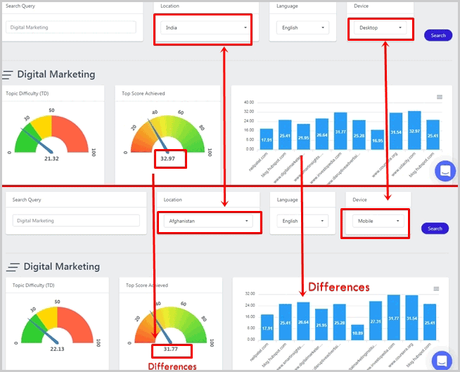
As is evident, the results aren’t identical. This clearly means the filters aren’t there just for show. They actually work!
Positive vibes so far! Let’s move on to actually “using” the tool?
Topic Difficulty- What data do we get?
Here’s a screenshot which captures most of the data that a keyword search on SearchContent’s topic-difficulty module will get you:
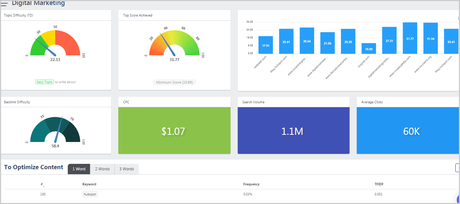
I’m impressed, thoroughly. It seems to cover everything that there is about content optimization (and even SEO).
The very first metric we see is the “Topic difficulty”.
It’s basically a difficulty-score from 0-100. Lower=easier ranking potential.
So we instantly know if a keyword is even worth perusing. Let’s say if you get a difficulty score of 45+, you’d know it’s not as easy. And maybe, you shift your attention to easier keywords, offering better rates of success.
Top Score
This is the “content score”.
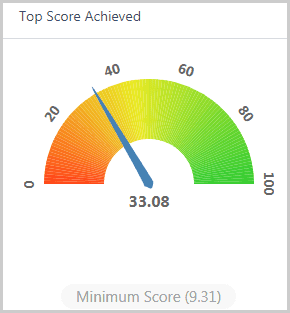
It calculates and displays the overall optimization of the keyword in an article/webpage.
It displays the “top score” by default. This is the highest score that the website ranking #1 for your keyword currently has.
Using the Content Optimizer tool (discussed later in this SimilarContent review), it’s pretty easy to optimize your content to match, or even exceed this score.
Top 10 websites
The next piece of data the module gets us is a chart, of the top 10 websites, and their content score.
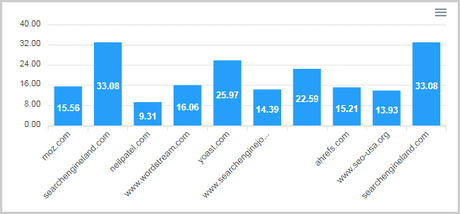
So, now we know exactly which website has the best and worst content optimization.
Note that this also gives us a glance at the top 10 websites for the keyword, for that region and device.
These are the top 10 competitors we ought to beat. Love the insight!
Actionable Intel: Backlinks, CPC, Search Volume and Average Clicks
Didn’t I mention in an earlier section of this SimilarContent review that it also can be used for keyword research?
Well, here’s why.
For any keyword, this is a section of data that’s presented:

The “Backlink Difficulty” is the first available metric.
It’s not the “number” of backlinks, rather, the difficulty-score.
In other words, it calculates the total no. of backlinks for each of the top 10 websites for your keyword, and then determines a difficulty score based on that. (Need more details? Scroll down to the “SERP Analysis” section on this SimilarContent review).
Then we get the CPC for a keyword. Another feature which helps us find more profitable keywords.
The exact search volume for the keyword and average clicks follow next.
You do see now how it can be used to find better keywords, don’t you? (Imagine all the money you’re saving! This literally can be used as a keyword research tool in addition to a content optimizer).
Keyword suggestions
The next section is labelled “To Optimize Content”. It shows us the keywords we need to target in our article, along with the primary keyword to rank better.
So, this section basically displays the top keywords we should be targeting for our primary keyword to rank better.
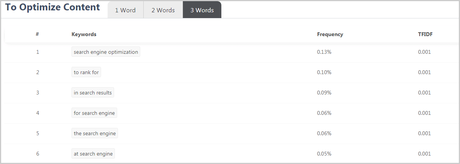
With Google paying attention to semantic keywords and the general “idea” of the content, it does come in handy.
This section also includes the following data:
- 1/2/3 word-keywords
- Keyword frequency.
- and TFIDF.
What pleased me was the fact that it took into account one-word, as well as long tail keywords.
The TFIDF score is an idea of the keywords’ “importance” so to speak.
Basically, prioritising keywords with higher TFIDF scores is the way to go.
Note that these keywords aren’t at random. Rather, SimilarContent derives these from the top 10 websites for that keyword.
So now, we get a bunch of LSIs and related keywords we can spray our content with. Higher rankings, here we come!
Google SERP Analysis
If you’re into actionable-data, this section is totally for you.
Here’s what it looks like:
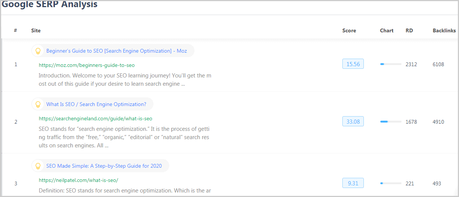
It displays the top results, their URL, and the meta-description.
Then there’s the “score” which is the content score we discussed earlier.
There’s even a chart. A horizontal version of the “content score”. Without having to scroll up, it gets us a graphical-representation of the content score. Kudos to the interface!
The “RD” and “Backlinks” are really the what impressed me. These show the total number of backlinks, as well as Referring Domains for that particular URL.
This is also how the “backlink difficulty” is calculated. The more RDs and backlinks the top results have on average, the higher goes the difficulty scale.
So now we also get an idea of how many backlinks we’ll require on an average to outrank the competition!
And that concludes everything that the “Topic difficulty” module presently has to offer.
Content Optimizer
Now, the Content Optimizer (is supposed to) help us craft better content.
It’s a live-editor, which suggests improvements to make the content better, in real-time.
Here’s what it looks like:

First impressions? Pretty impressive.
I broke it down in three sections for better understanding:
- The left sidebar.
- Editing-area.
- Right-sidebar.
The left-sidebar is purely dedicated to “Keywords”. It shows a number of related keywords.
This is the most important feature on the Content Optimizer.
It shows all the possible related keywords, using these helps us explain our content and its intent better to Google. Which in turn, results in better rankings.
The TFIDF for each keyword, as well as its desired frequency too is displayed.
The editing area is simply where we edit our content.
The finally, the right-sidebar is what suggests changes and current stats. It currently includes:
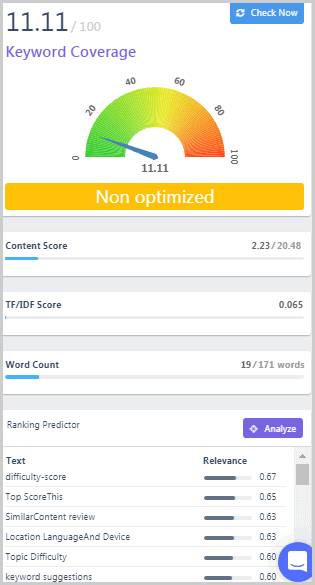
- Keyword coverage: Shows what % of the keywords suggested on the left-sidebar have actually been covered.
- Content score: Displays a desired content score, and the current score compared to it.
- Ranking predictor: Takes into account the currently covered keywords, and their relevance.
- TF/IDF score: Based on the keywords covered so far, determines a TF/IDF score for the content.
- Word count: It doesn’t indicate the content-length, rather the number of LSIs/related-keywords that we’ve covered in the content from the left-sidebar.
Did I mention you can also pull already-existing content off the web and optimize it? Or maybe, just analyze the optimization level on it.
A simple URL is all that’s required.
The “ease of use” is what makes it even more appealing. Anyone, even those without the least bit of skills can start using the content optimizer right away.
Readability score
Wait, why is this getting a special mention?
It too is a metric displayed on the right-sidebar. But, it’s so detailed, I just felt it has earned its own unique place on this SimilarContent review.
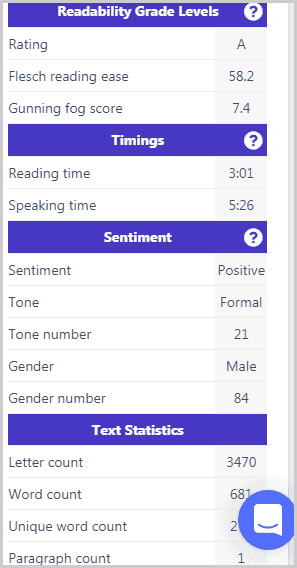
It really breaks down the content to a granular level.
The basics such as Flesch reading ease, Gunning Fog score, word count etc. are just some of the aspects it monitors.
Gunning..what? Or what even is a “readability score”?
If those are your questions, and you’re new to it all, the tool provides a “?” button next to the sections, explaining what some of these metrics are.
More importantly, it has a “sentiment” section. This includes minute details such as tone, gender, sentiment of the content (of course) etc.
Also displays the “Reading time” and “speaking time” of the content.
So that was the Content Optimization tool for you folks. Overall? Totally helps take the content up by quite a few notches.
SimilarContent Pricing Plans
Now that you’ve gone through this SimilarContent review; let’s see how pocket-friendly it is?
The good news: There’s a 7-day free trial package.
The better news: No cards/payment info needed for the trial!
As for the paid plans, 3 of those exist:
- Starter: $9.99/mo- 10 Topic difficulty searches /2 optimizations/day each.
- Business: $19.99/mo- 20 Topic difficulty searches / 5 optimizations/day each.
- Agency: $49.99/mo- 2 users/ 50 Topic difficulty / 10 optimizations/day each.
The company does have plans for quite a few additional modules, such as question analyzers, topic summarizer, headline optimizers to name a few.
However, they aren’t available as of now.
Payments can be made using PayPal and Cards.
SimilarContent Review: Final Verdict
So, is SimilarContent truly the best content optimizer in the industry?
I know not. But, I don’t see a lot missing with SimilarContent though, do you?
It packs data from the top 10 results, displays them in a pretty well-organized and usable format.
When done right, our content gets everything that the top results do, combined! I’d suppose it makes the content exponentially better, don’t you?
The fact that it displays actionable-data such as search volume, CPC, backlinks, RDs, on top of those hundreds of related keywords is quite the green light for me.
If you’ve heard of Marketmuse, or used it; you agree the tool costs a fortune? If you ask me, I’d say SimilarContent achieves most, if not all the results that Marketmuse may get us; at literally a fraction of the price.
So I personally am sure impressed.
Do let me know what you’re taking away from this SimilarContent review then? Both positive and negative, feedback helps!
